Hello fellow internet creatures. Today we will finally be finishing off (sort of) the aerodynamic side of the tail.
I mean, that was the plan, but then I got distracted by unending choices of aerofoils and did I mention life is busy?
If memory serves, we’ll need to cover the following:
- The aerofoils we’ll be using for the tail surfaces
- The dimensions of the flappy bits (aka rudder and elevator)
- Precisely where the tail is going to sit vs the wing
- … I think that’s it
Funnily enough, we’ll just be covering the aerofoil we need for the fin in this post… and that’s it.
So after a looooooong break during which life has been packed with great volumes of jam, I ask you, dear reader:
Won’t you share this jam with me?
Tail Aerofoils (Taerofoils? Aerotails?)
A very long time ago, we covered the aerofoils we’ll be using for the wing.
… And golly flipping gee, that got out of hand. We will try to avoid that level of text wall (I wrote this sentence about a month ago, and I don’t think I followed it to the letter).
K, right, onwards:
We want different things from our tailerfoil. Unlike wingerfoils, our aerotail will need to… you know what, these experimental hypothetical portmanteaus are messing with my thinking typing brain, and the feels part of my brain is becoming upset. Let’s move on.
Let’s start simple, and start on picking our fin aerofoil. What do we want?
- The fin aerofoil must be symmetrical. Otherwise it would constantly be trying to pull the tail off to one side, which would make our aircraft want to turn all the time and would generally make it much more draggy and horrible to fly.
- It mustn’t be too draggy, though since it’s much smaller than the wing, this isn’t such a big issue.
- It must behave in a relatively predictable way (we can’t have it wagging our aircraft around and stalling suddenly).
- The shape must be easy to build, and not have be so thin as to be fragile.

There are some other bits we might want to pay heed to like pitching moments at a more advanced level, but for now, let’s just get on with it.
I can’t think of a pun linking stalling and fins.
If I haven’t already mentioned before (and I can’t quite be bothered to check properly): it’s probably much harder to stall a fin than, say, a wing. You may remember how the angle of attack is the angle of the incoming air vs the aerofoil.
The thing is, the fin is an aerofoil sat on its side – so its angle of attack will be the same whether your nose is pointing up or pointing down. All the fin really cares about is the air coming in from left or right.
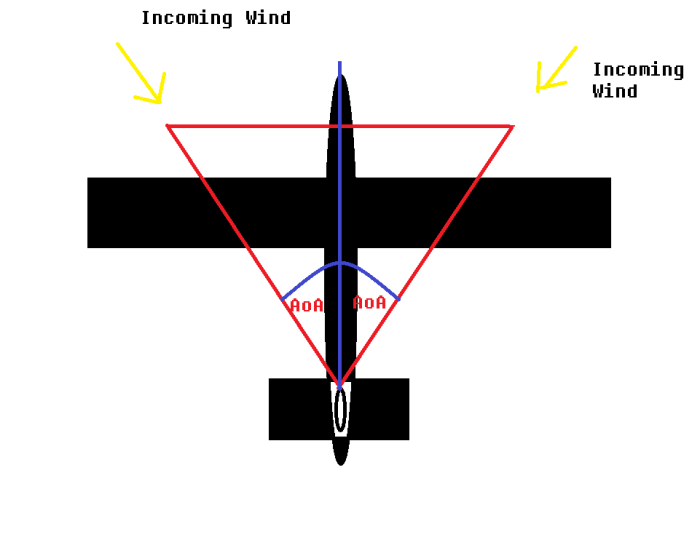
You might be able to stall it if you were yawing really fast, but since it’s pretty much the back end of a weathervane… it would be quite difficult. With the aircraft spinning round in a circle, one of the wings would be travelling faster than the other – you would likely cause the aircraft to enter a spin, which would present a very serious (and potentially unrecoverable) problem.
In summary: stalling fins is hard and you would cause bigger problems by trying to do so.
Flat plank? More like… no.
In truth, for a model of this size we could always settle for a flat plank which we could just sand the edges off… but this would be inelegant, and for a model of this size… I would never be happy with it.

Based on internet searching and general personal experience, most models use relatively thin symmetrical NACA and Eppler aerofoils if they’re not just planks.
With this context in mind, we might as well get on.
Warning: maths incoming.
RRRREEEEEEEEEEEE
Well, the next stage might as well be figuring out what kind of Reynolds number our tail will be flying at. We’ve already determined the tail should be symmetrical which excludes a huge swathe of aerofoils.
To refresh: Reynolds numbers are basically the ratio of the aircraft’s inertia to the viscosity of air. As far as we’re concerned, bigger Reynolds number = better performance.
Remember the formula from way back?
Reynolds Number = Density of Air x Airspeed x Chord Length ÷ Kinematic Viscosity of Air
And since we probably won’t be doing any extreme flying in extreme places, we can simplify:
Re = 1.225 x Airspeed x Chord Length ÷ 0.00001456 = Airspeed x Chord Length x 84130
And from our earlier posts, we already know that:
- Chord Length = Fin Chord = 0.14m
- Airspeed = Cruise Speed = 8.2m/s
So Re= 8.2 x 0.14 x 84130 ≈ 95000
So if we aim for aerofoils that behave well at Re=100000, we should be good. Just to be on the safe side, we’ll be keeping an eye on behaviour at Re=50000 and Re=200000 – this will mean we can spot any nasty behaviour around stall speed and… racing speed?
Picking Our Poison
Oh, now here’s something interesting:
This right here is a gaggle of graphs exploring the behaviour of the LWK 80-100 symmetrical aerofoil. It has a pretty high lift-to-drag ratio, which is great, but…. see how the lift just seems to flatten out between about -4 to +4 angle of attack?
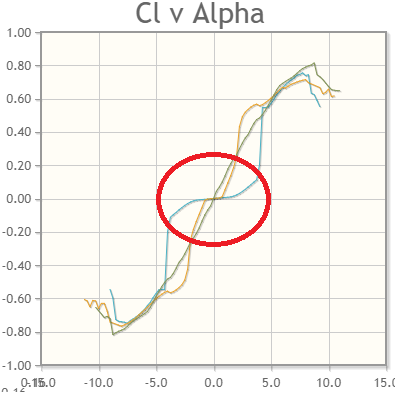
This aerofoil seems to have a dead zone – especially at Re=50000 (blue line – chances are the worst-behaving line will be from when the aerofoil is travelling the slowest). This will mean that changes of angle of attack between -4 and +4 degrees won’t change the lift provided, which is… well, imagine if you couldn’t walk in a straight line and had to keep correcting your course in a constant and imprecise zigzag. Trying to walk through a busy street would become even more stressful than usual (seriously, who put these people in the way?).
Now imagine trying to land an aircraft that won’t fly straight. That’s stressful.
Bottom line is: nope. This aerofoil is a no-go, which serves as a very useful example of what we want to avoid. Maximum lift-to-drag ratio is not the be-all and end-all!
Also, “zigzag” is a good word which I should use more often.
NEXT!
…
Oh hey, this behaviour is actually pretty widespread.
…
SCIENCE!
Looking at many of the graphs, it seems that some symmetrical aerofoils start behaving completely in reverse around these shallow angles of attack – their lift decreases with a higher angle of attack, before snapping back to normal past a critical point.
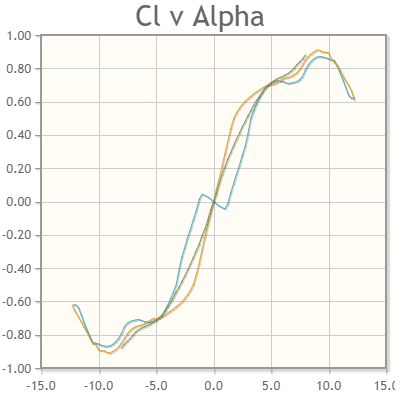
Spline Ho
There are a lot of aerofoils out there, any many seem to be quite samey on the whole lift/drag front. So in an unprecedented (for me) (well, at least since leaving university) effort, I’m going to compare the shapes against their lift-drag graphs.
You’re welcome, internet.
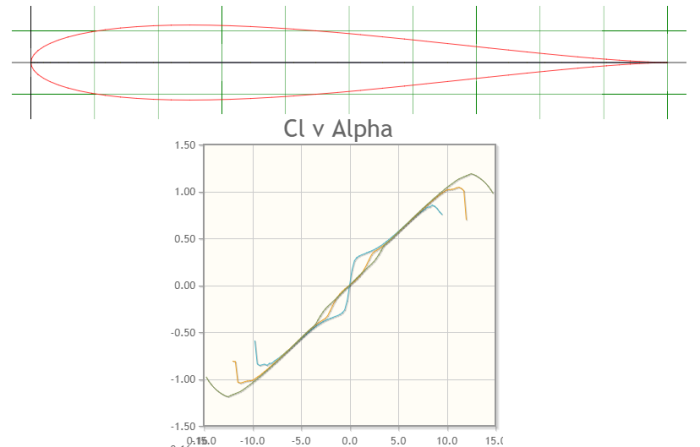
I saw a lot of this sort of behaviour – sharp lift response at mild angles of attack, tailing off towards the mids and extremes. The aerofoil’s behaviour seems unusually consistent across different angles of attack, with only the stall angles and slow-speed lift response varying significantly. Speaking of stall angles – the stall occurs at roughly 9°, which isn’t the best on test.
A simple aerofoil shape, curving off to a sharp trailing edge – this wouldn’t be too hard to trace or produce. It does get pretty thin at the back, though…
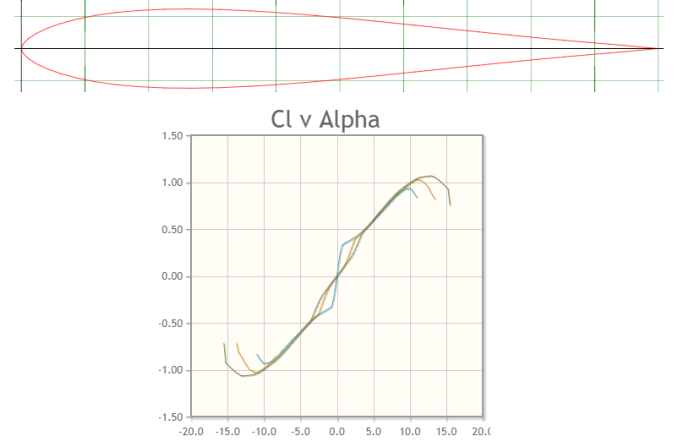
This aerofoil behaves relatively similarly to the one above (note the different scaling on the two graphs), but keeps flying at slightly steeper stall angles at all speed ranges.
From a mechanical standpoint, the taper is less pronounced, and thus would be less fragile.
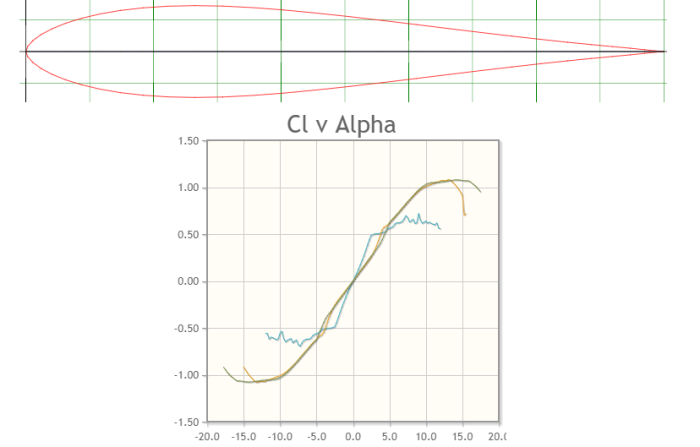
This slightly chubbier sibling of the E168 aerofoil seems to struggle with slow-speed flight at low speeds, though it does appear to fly better at higher speeds, with higher stall angles and a flatter response at the extremes that would give greater warning of an impending stall.
A marginal increase in thickness does benefit the trailing edge, though the slow-flight performance means this will only serve as an example of what to avoid where possible.

For our purposes, this is beautiful. The change in lift with angle of attack is almost linear, and seems to behave almost identically across all three speed ranges. Stall angle of about 12° is average, as is the warning of stalls. The maximum lift doesn’t quite match the other aerofoils we’ve been looking at, but that’s not the end of the world.
Aerodynamically, this is fantastic. Geometrically… it’s not the easiest shape in the world to trace, and that taper… yeesh.
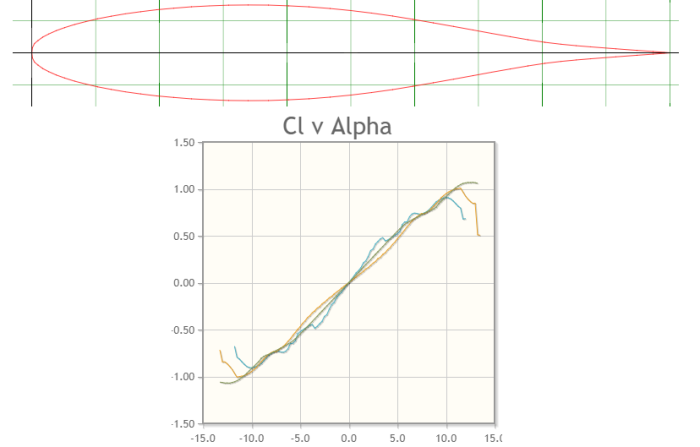
This… jiggly. Am suspicious.
The generally linear lift response and reasonable stall angles don’t quite offset my suspicion of the noisy slow-flight behaviour. Plus warning of the stall doesn’t seem to be in abundance.
Also taper. It looks like it would break if we were to poke it.
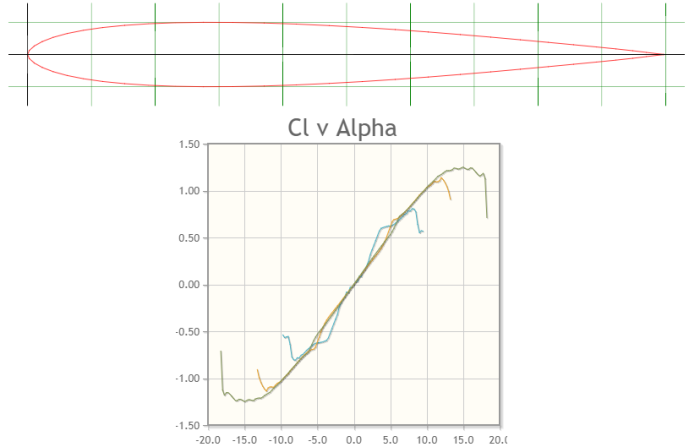
Nice easy shape to make, and pretty great mid to high-speed performance… but slow-speed performance just isn’t up to par.
This is a shame, because it looks nice to build and much less worrisome at the back.
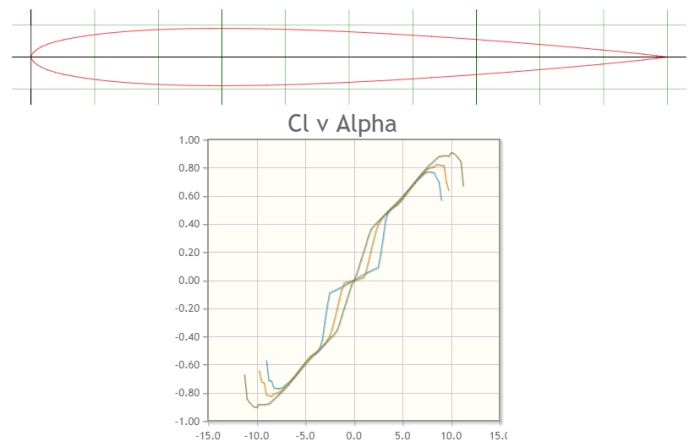
I think I tried to use this aerofoil back in university… and in truth, I can’t quite think why. The lift response across all speed ranges gets squashed in the middle, the stall angle (and warning of stall) is “meh” all over, and the maximum lift is way lower than the other aerofoils.
It does look quite easy to trace and build, with a shallow taper producing a relatively strong trailing edge.
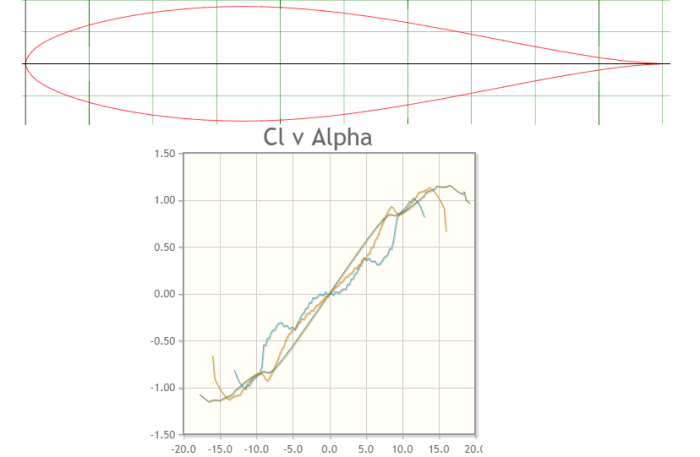
I don’t know why I put this aerofoil in this list.
What is even going on?
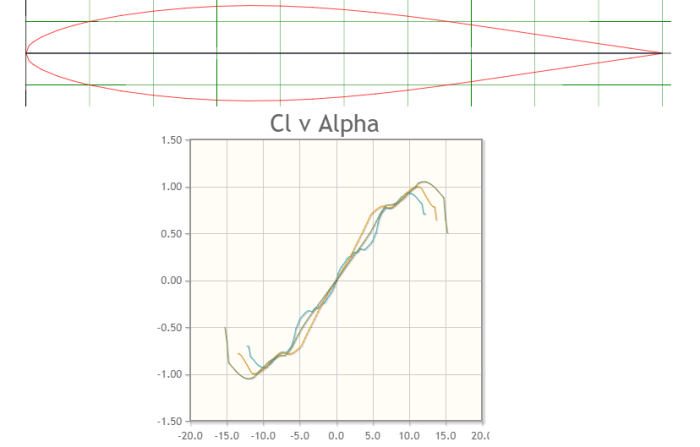
Unfortunately the slow-speed lift response is a bit weird on this one, though it does seem to behave better at higher speeds. Stall angels are reasonably good though.
It also looks nice and easy to build, with a strong trailing edge. You might even be able to install a servo directly into the fin, should you so desire.
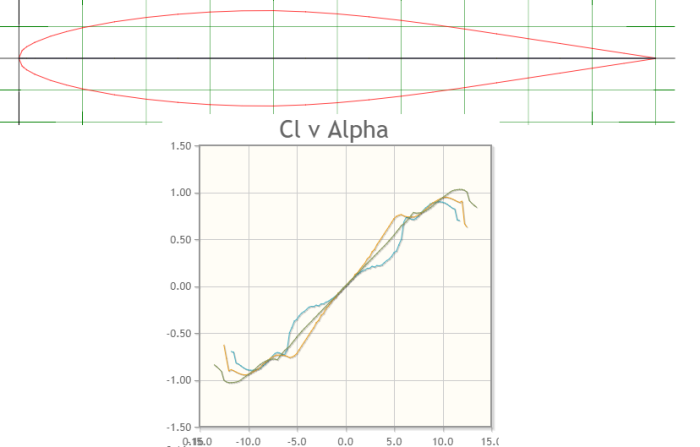
Same deal as above… but possibly slightly worse performance.
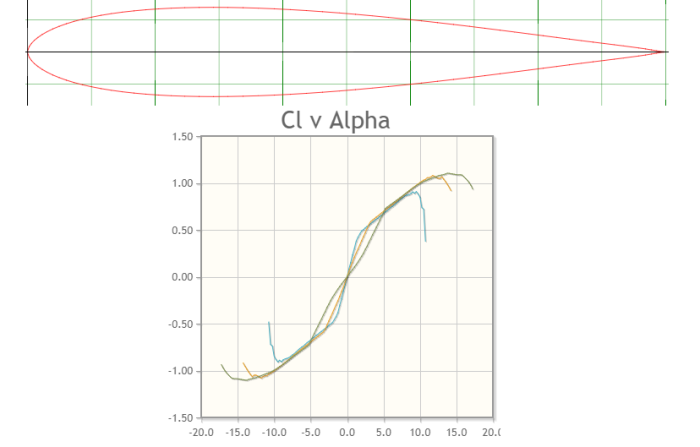
Generally nice performance here across all speed ranges, though the stall angle at low speeds is a little shallow. Lift response isn’t as linear as it could be, but it’s certainly not bad.
The shape appears to be reasonably easy to build, with a strong trailing edge.
Note: pretty much all my airfoil data (including the set below) is available from airfoiltools.com. It’s not great at giving recommendations, but if you know what you want from your aerofoils or know where to look for advice… this is likely the best source on the internet.
(Fin)al Round (see it’s funny because… oh, who am I kidding? Maybe this is why I always take so long to get new posts out.)
I think we’ve got it down to two aerofoils: the Eppler 520 vs the S8035 section. At this point, it’s a matter of aerodynamics vs geometry. The Eppler aerofoil is more consistent and better-behaved across all three flight modes… but would be a bloody nuisance to cut and transport with that super-thin trailing edge.
Let’s give them one last comparison…
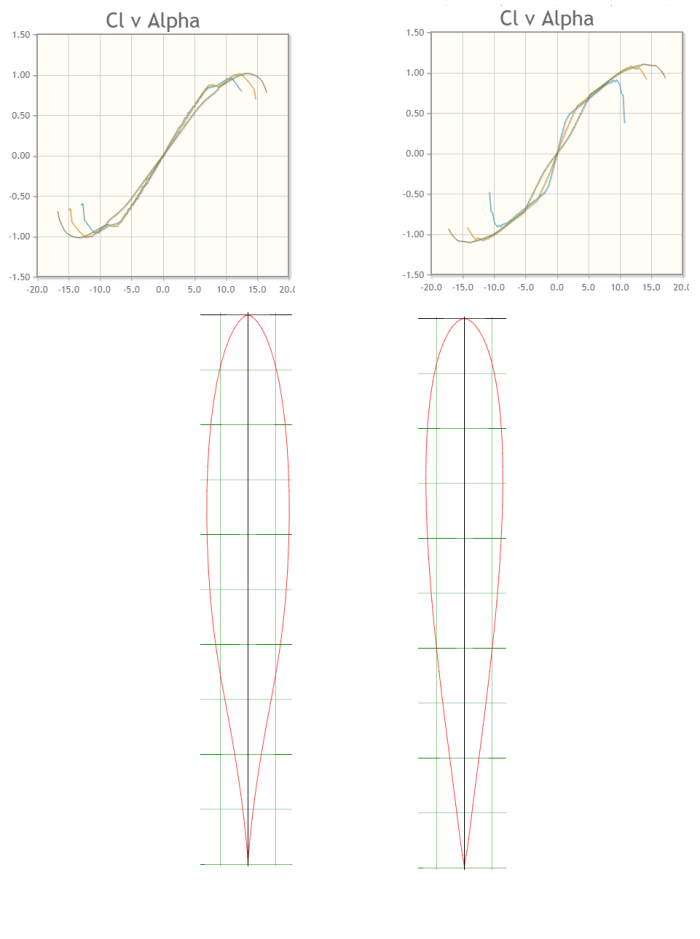
You know what? Executive decision time. This is a basic trainer, and if we do anything extreme with it, we are only asking for trouble. Let’s just make it easy to build and see how it goes.
S8035 it is!
Now, where were we?
Two Weeks Later…
Ok, no. This is getting stupid, and I will never get this post out the door if I try to finish everything in one go.
Whatever. Now you have a basic grip on how to choose a fin aerofoil.
We’ve still got to cover:
- How big the rudder is going to be
- The tailplane aerofoil (urgh)
- How big the elevator is going to be
- Why you should always stay hydrated
- Where the tail is going to sit (although this is kind of a structural thing, so we might just deal with it later)
- What would happen if you threw a jellyfish in a microwave
Well, I suppose I should go find something else to make me miserable. Wish me luck!